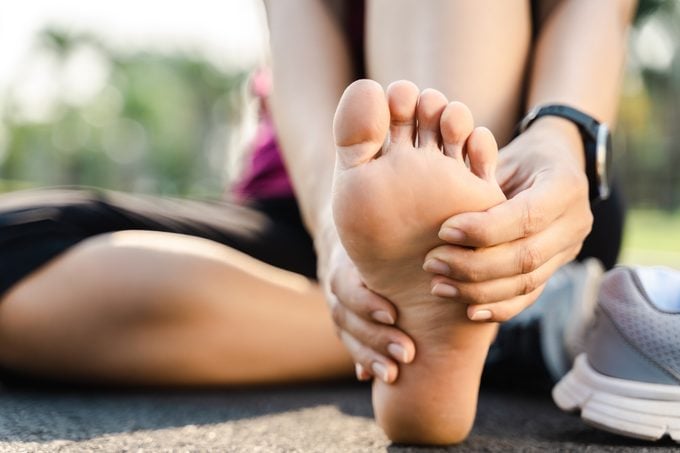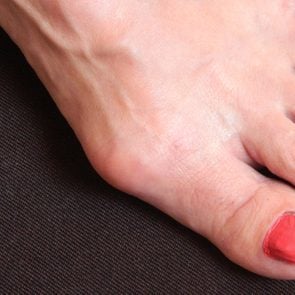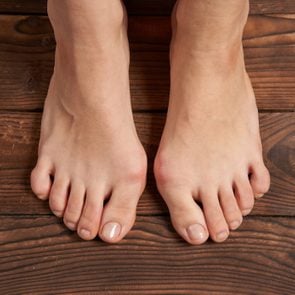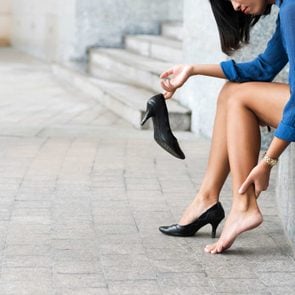Do You Have a Tailor’s Bunion? How to Tell—and What to Do About It
Updated: May 05, 2021
The painful, bony bump at the base of your pinky toe could be a tailor's bunion—a.k.a. a bunionette. Check out the causes, symptoms, and how to treat it.
Our editors and experts handpick every product we feature. We may earn a commission from your purchases.
What is a tailor’s bunion?
Centuries ago, tailors had a particular pose. They’d sit crossed-legged with the outsides of their feet rubbing against the floor.
The constant rubbing eventually led to a small but prominent bony bump at the base of the little toe, usually on both feet. Back then, the bump was dubbed a tailor’s bunion.
Today, it’s known as a bunionette. (And, yes, that sounds more like a cute hair accessory than a sore bunion near your pinky toe.)
If your feet are spending hours in tight or narrow shoes, you could be setting yourself up for bunionettes.
Here’s what you should know to avoid them and how to treat them if one is already popping out.
Tailor’s bunion vs. bunion: What’s the difference?
You probably already guessed this—they do, after all, both have the word “bunion” in the name—but the two conditions are very similar. What sets them apart is mainly location and size.
A tailor’s bunion appears at the base of the little toe, while bunions develop at the base of the big toe. Unsurprisingly, a tailor’s bunion is also smaller in size.
“Both are caused by malalignment of the metatarsal bone [the long bone in the foot] behind the toe in question and progressive weakening of the toe ligaments over time,” says Christopher Kidd, MD, an orthopedic surgeon at Cedars-Sinai Kerlan-Jobe Institute in Los Angeles.
Though bunions at the base of the big toe are more widely known, tailor’s bunions tend to be more common, according to Dr. Kidd.
“It’s simply because of the size of the toes,” he says. “The fifth toe and its ligaments are smaller and thus are more likely to deform under the pressures of everyday walking and tight-fitting shoes.”
(Speaking of toes, bunions and gout are both located near the big toe and cause pain and swelling. Can you tell the difference between gout and a bunion?)
Causes of tailor’s bunions
Maybe you’re an old-timey tailor who spends her days cross-legged on the floor. Or maybe you live in stilettos with tight toe boxes.
Either way, as a result of abnormal mechanics in the foot, the bone on the outside of the little toe slowly becomes rounded, splaying away from the outer side of the foot.
Poorly-fitted shoes
The most common cause of tailor’s bunions is wearing shoes that squeeze the toes into pointy or narrow toe boxes, constricting the front part of the foot.
This causes the fifth toe to turn inward, exposing the head of the metatarsal to the outside of the foot. Like this, it’s subjected to constant pressure from tight footwear, causing a bony bump to appear.
To prevent bunionettes, avoid this shoe mistake and opt for footwear with wider toe boxes.
Genetics
“I frequently hear that a patient ‘got my grandmother’s foot’ or ‘my dad’s toe,'” says Dr. Kidd. “Subtle changes in the alignment of the foot bones are frequently inherited characteristics, just like having broad shoulders or long fingers.”
When inherited alignment issues are severe enough to cause deformities in the foot, they usually begin in early childhood or adolescence.
“The fact that a close relative has problems with their foot or toes is no guarantee that you will as well,” he says.
It’s more common to develop tailor’s bunions later in adulthood from cramming your toes, day after day, into shoes that are too tight, narrow, or pointy.
Tight calf muscle
When the ankle joint doesn’t move as freely as it should, it can cause a tight calf muscle.
“This tightness in the calf muscle will cause biomechanical changes in which the forces of weight-bearing will be distributed to the front part of the foot or underneath the metatarsal heads,” explains Mark Mendeszoon, DPM, a podiatric physician and surgeon with Precision Orthopaedic Specialties in Chardon, Ohio.
Basically, when you walk around with tight calves, you are putting more pressure on the outside of the foot, and sometimes the forefoot, which contributes to a tailor’s bunion.
Other bunions
Other types of bunions, which can provoke misalignment, might trigger the initial stage for a tailor’s bunion.
An existing bunion at the base of the big toe can cause crowding and pressure that prompts a bunionette to form.
Foot issues
Certain foot conditions can contribute to a tailor’s bunion.
Generalized hypermobility and instability of the joints in the foot, or an outwardly bowed or misaligned fifth metatarsal bone that is lower than normal, may set up the fifth toe for a tailor’s bunion.
People with rheumatoid arthritis may have weakened ligaments that lead to fallen arches, which may invite bunion formation.
Gender
Women are more likely to get bunionettes than men. There are two factors going against women: They have weaker connective tissue. And they tend to wear narrow, high-heeled shoes.

Symptoms of a tailor’s bunion
Aside from a visible bump at the base of your pinky toe, you may experience some other symptoms of tailor’s bunions. The most common are pain, changes to the skin, and bunions on both feet.
Pain
The primary symptom is bunion pain. That said, some people only have pain when they wear shoes that are too tight and narrow.
When pain is present, it’s usually from wearing shoes that rub the skin and irritate the soft tissues underneath, causing a tender and inflamed bunion.
“You can also get pain on the outside of the fifth metatarsophalangeal joint or on the bottom under the fifth metatarsal head,” says Ami Sheth, DPM, a podiatric physician and surgeon at Foot and Ankle Associates in Los Gatos, California.
The metatarsophalangeal joints may be hard to say but they have an easy-to-understand job: they connect the toe bones to the foot bones.
Try these expert-approved bunion exercises to help reduce and prevent pain.
Skin changes
Calluses may form under the ball of the foot from rubbing between the bunion bump and tight shoes, or there may be hardened skin on the bottom of the foot.
“Some people will have a soft prominence [or fluid-filled sac called a bursa] that forms on the outside or under as well,” says Dr. Sheth.
Bunions on both feet
“Feet are symmetric,” says Dr. Sheth. “So if they have an issue, you might see the same structure on both feet.”
It’s not unusual to have one foot that is more deformed than the other. “Sometimes you can have pain on one side more than the other,” she says.
Diagnosing tailor’s bunions
If you see visible signs of a bunion or have some of the symptoms above, it’s time to see a doctor.
Typically, your podiatrist can diagnose you with a bunionette just by looking at your feet. A small, bony spur on the outside of the fifth metatarsal bone is normal, but if the spur is larger or sharper and painful, it is classified as a low-grade bunionette, Dr. Kidd says.
Once you’re diagnosed, you’ll probably get an X-ray so your doctor can determine the best way to treat it.
Treating a tailor’s bunion
Tailor’s bunions (and all bunion types) don’t happen overnight.
The protrusion gradually forms over a matter of years, so you may not even realize you have one until you’re in your 30s or 40s. But your toes and feet will be a lot happier and less painful the sooner you address the bunions.
Still, once bunion pops out, there’s no shrinking it.
“Like bunions, bunionettes are a permanent deformity caused by the alignment of the metatarsal bones,” says Dr. Kidd. “No splint or other miracle device can reverse the deformity of the toes, but these can help relieve friction and pressure over the painful area.”
Nonsurgical ways to treat bunion pain
The first steps to treating a tailor’s bunions don’t involve surgery. These are the most common ways to treat:
Ditch or stretch shoes that are too tight
If you’ve ever had a bunion while wearing shoes, you know how painful it is. It can get so bad that walking is difficult to walk.
The most effective way to reduce the tender pain of bunions is by wearing shoes that provide sufficient room in the toe box.
“The effect of wearing well-fitted shoes with ample space for the toes can’t be overstated. If the toes feel good in the shoe, they’ll be much more likely to stay painless in the long term,” says Dr. Kidd. “And wearing wider, more comfortable shoes may prevent pain from developing even with a severe bunionette deformity.”
The best shoes for bunions should have a wide enough toe box that the toes aren’t squished together, arch support, flexible material around the toes, and shock support.
You should also make sure your toes aren’t too close to the front of the shoe. Aim for a quarter to half-inch space between the longest toe and the front of the shoe.
If you just can’t part with your favorite (but tight-fitting) pair, a shoe repair shop may be able to stretch them.
Or you can buy a shoe stretcher with bunionette plugs to widen the toe box. A shoe stretcher spray might help loosen them up.
Try bunion pads
Bunion pads may claim to correct tailor’s bunions, but that’s just not possible. Surgery is the only way to correct a deformity.
They are, however, ideal for keeping tender bunion spots from rubbing against the inside of shoes.
Dr. Kidd, recommends silicone gel-based bunion pads, hands down. “Silicone is your friend,” he says. “It’s soft and provides great cushion.”
He says bunion pads made of felt might do the trick, but they take some time before they soften up.
Just don’t buy the plastic ones. “They are destined for the trash,” says Dr. Kidd.
Some pads come with loops or rings that hold them to your toes. Those are fine, as long as they’re not too tight.
Icing
Icing a tailor’s bunion can help reduce the swelling around the bump.
No ice pack? No problem. Here are seven doctor-approved way to make your own ice pack.
Pain relievers
Over-the-counter (OTC) pain relievers, such as aspirin, ibuprofen, and naproxen, can help reduce the pain and inflammation of the bunion.
Injections
Corticosteroid injections (steroid shots) are rarely necessary to treat bunion pain.
If the bunion is large and there is severe pain and sensitivity, your doctor may suggest corticosteroid injections for a short period of time.
Should you get a cortisone shot? It can help to weigh the pros and cons with your doctor.
Orthotic devices
Podiatrists may recommend custom orthotic devices when other foot conditions are present.
For example, orthotics can provide additional arch support for flat feet and prevent the shoe from slipping or moving with each step, which puts pressure on the fifth toe.
Complications
Good news: tailor’s bunions are much less likely than bunions to cause problems with the adjacent toes, Dr. Kidd says.
You can avert complications by wearing properly fitted shoes and using bunion pads, if necessary.
Bunions rarely cause worrisome complications unless they go without being treated.
If bunions continue without treatment, Dr. Mendeszoon says there are a few possible complications, including inflammation of the joint that connects the small toe to the foot and inflamed bursal tissue, which protects the fifth metatarsal bone from irritation from your shoe.
If the deformity is significant, your pinky toe might evolve into a hammertoe, with a callus or painful bursa.
Diabetes and bunions
People with diabetes may have nerve damage that causes sensation loss in the feet.
“When you have a tailor’s bunion, you can have undue pressure in that area and need to be concerned about excessive pressure,” says Dr. Sheth. “You need to be especially careful since you may not recognize when a shoe is too tight or rubbing on that area.”
That’s a problem because scrapes or sores that go unnoticed and untreated can worsen. And foot wounds are harder to heal in people with diabetes, which means they can spiral out of control.
Check your feet daily for thickening skin, callouses, bony protrusions, and anything out of the ordinary—including cuts, scrapes, blisters, or sores. Alert your doctor as soon as possible to start treating immediately and stay ahead of trouble.
Surgery
Surgical removal of a tailor’s bunion is rarely necessary when you stabilize the outer side of the foot and take weight the toe joint, Dr. Sheth says.
Bunion surgery is typically only necessary when pain is unbearable or to correct the deformity to improve bone alignment.
If you need surgery, you’ll undergo weight-bearing radiographs, which will help your doctor determine the extent of the deformity.
“The surgical correction may be a simple procedure that removes the bump on the side of the fifth metatarsal head or a procedure that requires a bone cut to correct the angular deformity,” says Dr. Mendeszoon.
Expect recovery to last a matter of weeks. It’ll be four to eight weeks before you’re walking comfortably in regular shoes again.
Next, here’s what you should know before you buy a bunion corrector.



